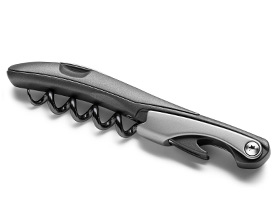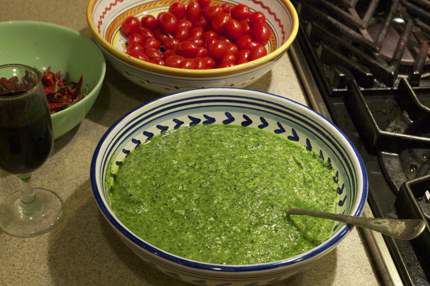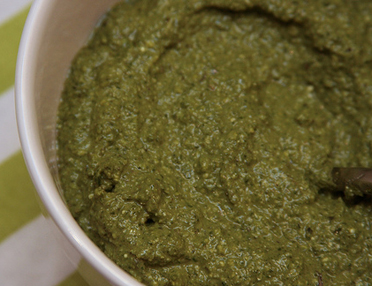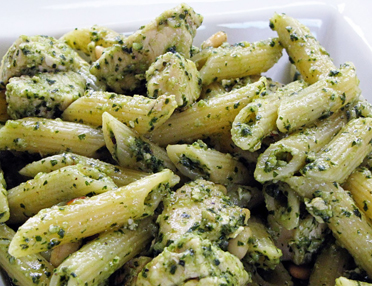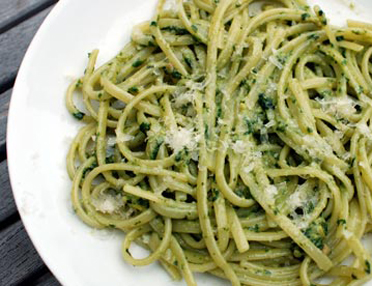home | meat grinders | sausage stuffers | sausage casings | e-mail SausageMania | NEW! Sausage Photo Tutorial | sausageMania recipes |more SausageMania recipes | motorize a grinder | tips | links | kippermania | loxmania | NEW! PestoMania | NEW! Even MORE SausageMania Recipes! | NEW! Lox Making Photo Tutorial | NEW! CaviarMania | NEW! Porcini Sausage!

Pesto: The GREEN Revolution! |
Pesto sauce, a Genovese basil-based specialty, was virtually unknown in the United States until the 1970’s, when the Early Renaissance of American Cooking made it an option (but never a special) at higher-end Italian restaurants. Now forty years later, this dazzlingly green sauce is still only infrequently found outside of our larger cities, and most of those are on one of the coasts. Like the Americanization of pizza after WWII, which has produced varieties of pizza no Neapolitan would recognize, much less consume, pesto, too, has undergone its own ignominious transmogrification with the introduction of non-traditional substitute ingredients, such as parsley, arugula or spinach instead of basil, walnuts instead of pine nuts, margarine instead of butter, canola or safflower oil instead of olive oil, and so forth.
SausageMania has zero tolerance for "nouvelle" or "fusion" cuisine, which deserves to be regarded as pantywaist cookery, catering to a Yuppie Generation of Bored Self-Styled Epicures Always in Search of a Novel Gustatory Thrill: the Lotus Eaters of the 21st Century.
You know the type: he goes about armed with a Code38 Professional Waiter's Wine Knife in a belt holster. He arrives at the dinner party with his black, foam-lined Zero Halliburton p4-Stealth Carbon Fiber case in which special wine glasses are lovingly cradled, $200 glasses of precisely the right silicon content, shape, curve and heft, designed to amplify the least nuance of whatever wine the host sets out for his guests — or to expose the host's oenological naiveté, the unappealable verdict being delivered sotto voce to dinner partners on either side in tones of regretful superiority.
The $450 Code38 Stealth Wine Knife, available from Code38.com. It's made of surgical stainless steel with a fortified TiCN coating, creating "a tactile blend of textures and finishes…designed for professional sommeliers, and lovers of wine." A Must-Have for the committed wine enthusiast.
The $2,500 Zero Halliburton p4-Stealth Carbon Fiber Wine Glass Attaché Case, "unrivaled in class, style and sophistication… the perfect case for showcasing your individuality." [Wine glass foam insert must be ordered separately at $104.66.]
The Rona Steelite $200 5-Star Grand Vin Conoisseur Wine Glass, with Special Rim Treatment and Pulled Stem Technology, "to Bring out the Best in Your Fine Wines."
But enough vituperation (and product placement).
PestoMania deals with only the Holy Grail of Genovese Pesto, with a sole exception: as mentioned below, pistachio nuts may be substituted for pine nuts, but a special advance dispensation is required from the Archbishop of Genoa if you plan to do it, and you may end up in Hell anyway for having committed a venial culinary sin. Or maybe 500-1,000 years in Limbo, if you are lucky, and if your Pesto was better than middling.
Pesto sauce is named for the male tool used to make it, the pestle, though what happened to the poor female mortar is obscure: whatever feminists may be among SausageMania's readers can chew on that if they care to. Sexist objections notwithstanding, some purists maintain that only with the mortar and pestle can the true essence of basil be released and properly fused with the other ingredients. Poppycock! These detractors are the same folks who maintain that vinyl LP’s reproduce music more faithfully than digital devices, though by now most of them (who are not dead yet) have iPods anyway.
The blender is now The Tool of Choice for making pesto (a food processor is OK as well). Besides, finding a real mortar and pestle these days is as hard as finding a turntable!
A Vintage Blender From Yesteryear: Two Speeds: Low, High (and "Off"). |
PestoMania is Featured at Life As A Human, |
In deference to the tradition of naming this sauce after the tool used to make it, viz., the blender, we will henceforth refer to it as “BLENDO.”
Blendo is one of those felicitous harmonies of incongruous ingredients: basil, garlic, pine nuts, olive oil, butter and Parmesan cheese, though some recipes suggest a small amount of Pecorino Romano for an extra kick. Like the Holy Trinity of Cajun and Creole cuisine — bell peppers, onions and celery — the classical components of blendo ought not be tampered with. True, it may be a sacrilege to re-name it "blendo," but that affects neither its appearance, consistency, flavor nor the authenticity of the product. Blendo by any other name is just as green.
A few general do's and don't's about blendo… Do not buy it in a jar: make it yourself. The ersatz stuff that comes in jars is not worth the price of the least expensive pasta you might put it on! Use only the freshest ingredients, and try to get hold of genuine Italian Parmesan and Pecorino cheeses, which are easier to find than ever before. Domestic "Parmesan" is unacceptable — a rubbery, tasteless parody of the real thing. You may as well use Velveeta or CheezWhiz.
Use only fresh Genovese basil (not Thai basil or lemon basil), and do not try to substitute parsley, arugula, broccoli, cilantro or spinach, as some demented people recommend: the results are awful-tasting. Similarly, use fresh pine nuts: because pine nuts are oily, they will become rancid if left on the shelf. Most pine nuts for sale in the US come from China, which has basically cornered the market, so that they have become quite expensive, as much as $30/pound, even at Costco. Nonetheless, a pound will last a long time, and the unused pine nuts can be frozen.
Some cooks, because of the cost and scarcity of pine nuts, have substituted walnuts or even almonds. Avoid this lethal mistake, as it makes an un-blendo-like sauce. Walnuts add a nasty bitterness of their own, which reinforces and clashes with the bitterness of the raw basil, rather than neutralizing it, which is what the pine nuts do. Pistachio nuts, however, make an acceptable substitute. In controlled, double-blind tests, teams of highly trained blendo tasters could not distinguish between blendo made with pine nuts and blendo made with pistachios. Most pistachio nuts are salted, however, so if you use them, taste the final product before adding any salt.
Now Here Is The Special FREE Blendo Secret! Basil, depending on the season, variety and its maturity, will sometimes turn brown or khaki-colored after blending, due to oxidation, giving the product an unappetizing appearance (the taste, however, is unaffected). To avoid this, blanch the basil in boiling water for a few seconds and then immediately chill it in cold water. The boiling water denatures the enzymes that cause discoloration, so blendo made with blanched basil is emerald green, and stays that way, even after days in the refrigerator or weeks in the freezer.
This is how your Blendo should look when the basil has been blanched.
This is how your Blendo might look — Yuck!! — if you don't blanch your basil.
One last caution: never, never, never heat blendo on the range or in the microwave. Heating will cause the cheese to release its own oils and to clot, producing a green, greasy, inedible glop. If you want to heat your blendo, put it in a bowl, place the bowl in a sink of warm water and stir frequently until evenly warmed.
OK: enough pontificating. Here comes the blendo recipe. It will serve four.
• 2 cups of fresh Genoa basil, washed, blanched and cooled.
• 2 tbs pine nuts
• 2-4 cloves of garlic, depending on size, coarsely chopped
• 3/8 cup of olive oil
• ¾ cup grated Italian Parmesan cheese
• ¼ cup grated Pecorino Romano cheese (optional)
• 2 tbs softened butter
• salt and ground black pepper to taste
1. Put the oil and pine nuts in blender and blend. While blender is running…
2. Add the garlic
3. When nuts and garlic are no larger than coarse salt grains, add the basil and blend another 30-40 seconds
4. Put the two grated cheeses in a bowl
5. Add the contents of the blender and mix together with the softened butter.
6. Add salt and pepper to taste; serve over a good grade of imported pasta (no Mueller's or Golden Grain pseudopasta).
Pesto with Penne Rigate |
Pesto with Linguine |

